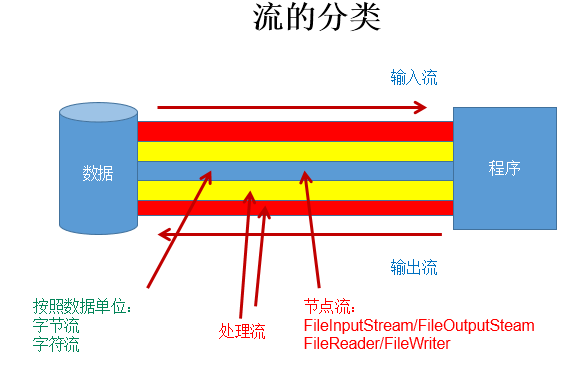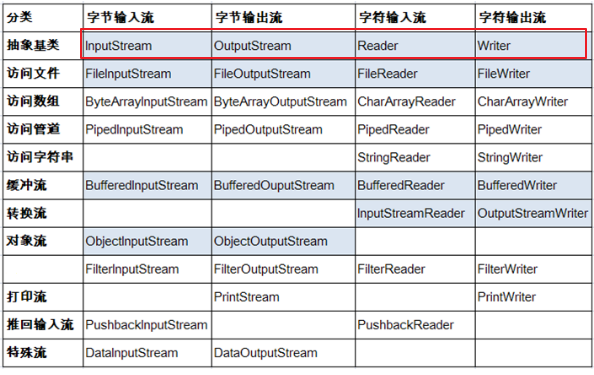File类的使用
File类的实例化
File(String filePath)
File(String parentPath,String childPath)
File(File parentFile,String childPath)
// 构造器1
File file1 = new File("hello.txt");
File file2 = new File("D:\\桌面\\新的开始\\Java\\code\\he.txt");
System.out.println(file1);
System.out.println(file2);
// 构造器2
File file3 = new File("D:\\桌面\\新的开始\\Java", "code");
System.out.println(file3);
// 构造器3
File file4 = new File(file3, "hi.txt");
System.out.println(file4);File类的常用方法
File类的获取功能
public String getAbsolutePath():获取绝对路径
public String getPath() :获取路径
public String getName() :获取名称
public String getParent():获取上层文件目录路径。若无,返回null
public long length() :获取文件长度(即:字节数)。不能获取目录的长度。
public long lastModified() :获取最后一次的修改时间,毫秒值
// 这两个方法适用于文件目录
public String[] list() :获取指定目录下的所有文件或者文件目录的名称数组
public File[] listFiles() :获取指定目录下的所有文件或者文件目录的File数组
File类的重命名功能
public boolean renameTo(File dest):把文件重命名为指定的文件路径
例如:file1.renameTo(file2)
调用这个方法的时候要保证.file2在硬盘中不存在
File类的判断功能
public boolean isDirectory():判断是否是文件目录
public boolean isFile() :判断是否是文件
public boolean exists() :判断是否存在
public boolean canRead() :判断是否可读
public boolean canWrite() :判断是否可写
public boolean isHidden() :判断是否隐藏
File类的创建功能
创建硬盘中对应的文件或文件目录
public boolean createNewFile() :创建文件。若文件存在,则不创建,返回false
public boolean mkdir() :创建文件目录。如果此文件目录存在,就不创建了。如果此文件目录的上层目录不存在,也不创建。
public boolean mkdirs() :创建文件目录。如果此文件目录存在,就不创建了。如果上层文件目录不存在,一并创建
File类的删除功能
删除磁盘中的文件或文件目录
public boolean delete():删除文件或者文件夹
删除注意事项:Java中的删除不走回收站。IO流概述
流的分类
- 操作数据单位:字节流、字符流
- 数据的流向:输入流、输出流
- 流的角色:节点流、处理流
 流的分类
流的分类
流的体系结构
 流的体系结构
流的体系结构
说明:红框对应的是IO流中的4个抽象基类。
蓝框的流需要大家重点关注。
比较重要的几个流结构
 重要的流结构
重要的流结构
输入、输出的标准化过程
输入过程
说明:程序中出现的异常需要使用try-catch-finally处理。
- 创建File类的对象,指明读取的数据的来源。(要求此文件一定要存在)
- 创建相应的输入流,将File类的对象作为参数,传入流的构造器中
- 具体的读入过程:
创建相应的byte[] 或 char[]。- 关闭流资源
输出过程
说明:程序中出现的异常需要使用try-catch-finally处理。
- 创建File类的对象,指明写出的数据的位置。(不要求此文件一定要存在)
- 创建相应的输出流,将File类的对象作为参数,传入流的构造器中
- 具体的写出过程:
write(char[]/byte[] buffer,0,len)- 关闭流资源
节点流(或文件流)
FileReader/FileWriter的使用:
FileReader的使用
说明点:
read()的理解:返回读入的一个字符。如果达到文件末尾,返回-1- 异常的处理:为了保证流资源一定可以执行关闭操作。需要使用
try-catch-finally处理- 读入的文件一定要存在,否则就会报
FileNotFoundException。
@Test
public void testFileReader1() {
FileReader fr = null;
try {
//1.File类的实例化
File file = new File("hello.txt");
//2.FileReader流的实例化
fr = new FileReader(file);
//3.读入的操作
//read(char[] cbuf):返回每次读入cbuf数组中的字符的个数。如果达到文件末尾,返回-1
char[] cbuf = new char[5];
int len;
// 循环结束是关键
while((len = fr.read(cbuf)) != -1){
//正确的写法
String str = new String(cbuf,0,len); // 这里调用的方法是关键
System.out.print(str);
}
} catch (IOException e) {
e.printStackTrace();
} finally {
// 资源关闭判断是否为空
if(fr != null){
//4.资源的关闭
try {
fr.close();
} catch (IOException e) {
e.printStackTrace();
}
}
}
}FileWriter的使用
说明:
- 输出操作,对应的File可以不存在的。并不会报异常
- File对应的硬盘中的文件如果不存在,在输出的过程中,会自动创建此文件。
File对应的硬盘中的文件如果存在:
如果流使用的构造器是:FileWriter(file,false) / FileWriter(file):对原文件的覆盖
如果流使用的构造器是:FileWriter(file,true):不会对原文件覆盖,而是在原文件基础上追加内容
@Test
public void testFileWriter() {
FileWriter fw = null;
try {
//1.提供File类的对象,指明写出到的文件
File file = new File("hello1.txt");
//2.提供FileWriter的对象,用于数据的写出
fw = new FileWriter(file,false);
//3.写出的操作
fw.write("I have a dream!\n");
fw.write("you need to have a dream!");
} catch (IOException e) {
e.printStackTrace();
} finally {
//4.流资源的关闭
if(fw != null){
try {
fw.close();
} catch (IOException e) {
e.printStackTrace();
}
}
}
}文本文件的复制
@Test
public void testFileReaderFileWriter() {
FileReader fr = null;
FileWriter fw = null;
try {
//1.创建File类的对象,指明读入和写出的文件
File srcFile = new File("hello.txt");
File destFile = new File("hello2.txt");
//不能使用字符流来处理图片等字节数据
// File srcFile = new File("爱情与友情.jpg");
// File destFile = new File("爱情与友情1.jpg");
//2.创建输入流和输出流的对象
fr = new FileReader(srcFile);
fw = new FileWriter(destFile);
//3.数据的读入和写出操作
char[] cbuf = new char[5];
int len;//记录每次读入到cbuf数组中的字符的个数
while((len = fr.read(cbuf)) != -1){
//每次写出len个字符
fw.write(cbuf,0,len);
}
} catch (IOException e) {
e.printStackTrace();
} finally {
//4.关闭流资源
//方式二:
try {
if(fw != null)
fw.close();
} catch (IOException e) {
e.printStackTrace();
}
try {
if(fr != null)
fr.close();
} catch (IOException e) {
e.printStackTrace();
}
}
}FileInputStream / FileOutputStream的使用:
- 对于文本文件(.txt,.java,.c,.cpp),使用字符流处理
- 对于非文本文件(.jpg,.mp3,.mp4,.avi,.doc,.ppt,…),使用字节流处理
/*
实现对图片的复制操作
*/
@Test
public void testFileInputOutputStream() {
FileInputStream fis = null;
FileOutputStream fos = null;
try {
//1.造文件
File srcFile = new File("爱情与友情.jpg");
File destFile = new File("爱情与友情2.jpg");
//2.造流
fis = new FileInputStream(srcFile);
fos = new FileOutputStream(destFile);
//3.复制的过程
byte[] buffer = new byte[5];
int len;
while((len = fis.read(buffer)) != -1){
fos.write(buffer,0,len);
}
} catch (IOException e) {
e.printStackTrace();
} finally {
if(fos != null){
//4.关闭流
try {
fos.close();
} catch (IOException e) {
e.printStackTrace();
}
}
if(fis != null){
try {
fis.close();
} catch (IOException e) {
e.printStackTrace();
}
}
}
}缓冲流的使用
相关类
BufferedInputStreamBufferedOutputStreamBufferedReaderBufferedWriter
作用
作用:提供流的读取、写入的速度
提高读写速度的原因:内部提供了一个缓冲区。默认情况下是8kb
 缓冲区大小
缓冲区大小
使用
处理非文本文件
//实现文件复制的方法
public void copyFileWithBuffered(String srcPath,String destPath){
BufferedInputStream bis = null;
BufferedOutputStream bos = null;
try {
//1.造文件
File srcFile = new File(srcPath);
File destFile = new File(destPath);
//2.造流
//2.1 造节点流
FileInputStream fis = new FileInputStream((srcFile));
FileOutputStream fos = new FileOutputStream(destFile);
//2.2 造缓冲流
bis = new BufferedInputStream(fis);
bos = new BufferedOutputStream(fos);
//3.复制的细节:读取、写入
byte[] buffer = new byte[1024];
int len;
while((len = bis.read(buffer)) != -1){
bos.write(buffer,0,len);
}
} catch (IOException e) {
e.printStackTrace();
} finally {
//4.资源关闭
//要求:先关闭外层的流,再关闭内层的流
if(bos != null){
try {
bos.close();
} catch (IOException e) {
e.printStackTrace();
}
}
if(bis != null){
try {
bis.close();
} catch (IOException e) {
e.printStackTrace();
}
}
//说明:关闭外层流的同时,内层流也会自动的进行关闭。关于内层流的关闭,我们可以省略.
// fos.close();
// fis.close();
}
}处理文本文件
@Test
public void testBufferedReaderBufferedWriter(){
BufferedReader br = null;
BufferedWriter bw = null;
try {
//创建文件和相应的流
br = new BufferedReader(new FileReader(new File("dbcp.txt")));
bw = new BufferedWriter(new FileWriter(new File("dbcp1.txt")));
//读写操作
//方式一:使用char[]数组
// char[] cbuf = new char[1024];
// int len;
// while((len = br.read(cbuf)) != -1){
// bw.write(cbuf,0,len);
// // bw.flush();
// }
//方式二:使用String
String data;
while((data = br.readLine()) != null){
//方法一:
// bw.write(data + "\n");//data中不包含换行符
//方法二:
bw.write(data);//data中不包含换行符
bw.newLine();//提供换行的操作
}
} catch (IOException e) {
e.printStackTrace();
} finally {
//关闭资源
if(bw != null){
try {
bw.close();
} catch (IOException e) {
e.printStackTrace();
}
}
if(br != null){
try {
br.close();
} catch (IOException e) {
e.printStackTrace();
}
}
}
}转换流的使用
转换流:属于字符流
InputStreamReader:将一个字节的输入流转换为字符的输入流OutputStreamWriter:将一个字符的输出流转换为字节的输出流作用:提供字节流与字符流之间的转换
转换流的图示
- 解码:字节、字节数组 —>字符数组、字符串
- 编码:字符数组、字符串 —> 字节、字节数组
- 说明:编码决定了解码的方式
使用
InputStreamReader的使用,实现字节的输入流到字符的输入流的转换
@Test
public void test1() {
InputStreamReader isr = null;
try {
FileInputStream fis = new FileInputStream("dbcp.txt");
isr = new InputStreamReader(fis, "utf-8");
char[] cbuf = new char[30];
int len;
while ((len = isr.read(cbuf)) != -1) {
String str = new String(cbuf, 0, len);
System.out.print(str);
}
} catch (IOException e) {
e.printStackTrace();
} finally {
if (isr != null) {
try {
isr.close();
} catch (IOException e) {
e.printStackTrace();
}
}
}
}综合使用InputStreamReader和OutputStreamWriter
@Test
public void test2() {
InputStreamReader isr = null;
OutputStreamWriter osw = null;
try {
// 1.造文件造流
isr = new InputStreamReader(new FileInputStream("src/com/teng/Java2/IO/io/dbcp.txt"), "utf-8");
osw = new OutputStreamWriter(new FileOutputStream("src/com/teng/Java2/IO/io/dbcp_gbk.txt"), "gbk");
// 2.读写过程
char[] cbuf = new char[30];
int len;
while ((len = isr.read(cbuf)) != -1) {
osw.write(cbuf, 0, len);
}
} catch (IOException e) {
e.printStackTrace();
} finally {
// 3.资源的关闭
if (osw != null) {
try {
osw.close();
} catch (IOException e) {
e.printStackTrace();
}
}
if (isr != null) {
try {
isr.close();
} catch (IOException e) {
e.printStackTrace();
}
}
}
}
}其他的流的使用
标准的输入输出流
System.in:标准的输入流,默认从键盘输入System.out:标准的输出流,默认从控制台输出修改默认的输入和输出行为:
System类的setIn(InputStream is) / setOut(PrintStream ps)方式重新指定输入和输出的流。
@Test
public void test() {
BufferedReader br = null;
try {
// 1.创建流
br = new BufferedReader(new InputStreamReader(System.in));
// 2.处理
while (true) {
System.out.print("请输入字符串: ");
String str = br.readLine();
if ("e".equalsIgnoreCase(str) || "exit".equalsIgnoreCase(str)) {
System.out.println("程序结束");
break;
}
System.out.println(str.toUpperCase()); // 转换为大写
}
} catch (IOException e) {
e.printStackTrace();
} finally {
if (br != null) {
// 3.资源的关闭
try {
br.close();
} catch (IOException e) {
e.printStackTrace();
}
}
}
}打印流
PrintStream和PrintWriter说明:
- 提供了一系列重载的print()和println()方法,用于多种数据类型的输出
System.out返回的是PrintStream的实例
@Test
public void test2() {
PrintStream ps = null;
try {
FileOutputStream fos = new FileOutputStream(new File("ASCII.txt"));
// 创建打印输出流,设置为自动刷新模式(写入换行符或字节 '\n' 时都会刷新输出缓冲区)
ps = new PrintStream(fos, true);
if (ps != null) {// 把标准输出流(控制台输出)改成文件
System.setOut(ps);
}
for (int i = 0; i <= 255; i++) { // 输出ASCII字符
System.out.print((char) i);
if (i % 50 == 0) { // 每50个数据一行
System.out.println(); // 换行
}
}
} catch (FileNotFoundException e) {
e.printStackTrace();
} finally {
if (ps != null) {
ps.close();
}
}
}数据流
DataInputStream和DataOutputStream作用:用于读取或写出基本数据类型的变量或字符串
写出到文件
@Test
public void test3() {
DataOutputStream dos = null;
try {
// 1.创建流
dos = new DataOutputStream(new FileOutputStream("src/com/teng/Java2/IO/io/name.txt"));
// 2.数据操作
dos.writeUTF("刘欢");
dos.flush();//刷新操作,将内存中的数据写入文件
dos.writeInt(18);
dos.flush();
dos.writeBoolean(true);
dos.flush();
} catch (IOException e) {
e.printStackTrace();
} finally {
// 3.资源关闭
if (dos != null) {
try {
dos.close();
} catch (IOException e) {
e.printStackTrace();
}
}
}
}从文件读取
//注意点:读取不同类型的数据的顺序要与当初写入文件时,保存的数据的顺序一致!
@Test
public void test4() {
DataInputStream dis = null;
try {
// 1.创建流
dis = new DataInputStream(new FileInputStream("src/com/teng/Java2/IO/io/name.txt"));
// 2.数据操作
String name = dis.readUTF();
int age = dis.readInt();
boolean isMale = dis.readBoolean();
System.out.println("name = " + name);
System.out.println("age = " + age);
System.out.println("isMale = " + isMale);
} catch (IOException e) {
e.printStackTrace();
} finally {
if (dis != null) {
// 3.资源关闭
try {
dis.close();
} catch (IOException e) {
e.printStackTrace();
}
}
}
}
}对象流的使用
对象流:
ObjectInputStream和ObjectOutputStream作用
ObjectOutputStream:内存中的对象—>存储中的文件、通过网络传输出去:序列化过程ObjectInputStream:存储中的文件、通过网络接收过来 —>内存中的对象:反序列化过程对象的序列化机制:
对象序列化机制允许把内存中的Java对象转换成平台无关的二进制流,从而允许把这种二进制流持久地保存在磁盘上,或通过网络将这种二进制流传输到另一个网络节点。
当其它程序获取了这种二进制流,就可以恢复成原来的Java对象
示例代码
序列化过程:将内存中的java对象保存到磁盘中或通过网络传输出去
@Test
public void testObjectOutputStream() {
ObjectOutputStream oos = null;
try {
// 创造流
oos = new ObjectOutputStream(new FileOutputStream("object.dat"));
// 创造对象
oos.writeObject(new String("我是中国人,我感到很自豪。"));
// 刷新操作
oos.flush();
oos.writeObject(new Person("张三", 18));
oos.flush();
// 这里需要一个Account类
oos.writeObject(new Person("张三", 18, new Account(180)));
oos.flush();
} catch (IOException e) {
e.printStackTrace();
} finally {
if (oos != null) {
try {
oos.close();
} catch (IOException e) {
e.printStackTrace();
}
}
}
}反序列化:将磁盘文件中的对象还原为内存中的一个java对象
@Test
public void testObjectInputStream() {
ObjectInputStream ois = null;
try {
ois = new ObjectInputStream(new FileInputStream("object.dat"));
Object obj = ois.readObject();
String str = (String) obj;
System.out.println(str);
Person person1 = (Person) ois.readObject();
System.out.println(person1);
Person person2 = (Person) ois.readObject();
System.out.println(person2);
} catch (IOException e) {
e.printStackTrace();
} catch (ClassNotFoundException e) {
e.printStackTrace();
} finally {
if (ois != null) {
try {
ois.close();
} catch (IOException e) {
e.printStackTrace();
}
}
}
}
}实现序列化的对象所属的类需要满足的条件(重要)
点击查看
- 需要实现接口:Serializable
- 当前类提供一个全局常量:serialVersionUID
- 除了当前Person类需要实现Serializable接口之外,还必须保证其内部所属性也必须是可序列化的。(默认情况下,基本数据类型可序列化)
RandomAccessFile的使用
随机存取文件流:
RandomAccessFile使用说明
RandomAccessFile直接继承于java.lang.Object类,实现了DataInput和DataOutput接
RandomAccessFile既可以作为一个输入流,又可以作为一个输出流
- 如果RandomAccessFile作为输出流时,写出到的文件如果不存在,则在执行过程中自动创建。
- 如果写出到的文件存在,则会对原有文件内容进行覆盖。(默认情况下,从头覆盖)
可以通过相关的操作,实现
RandomAccessFile“插入”数据的效果
示例代码
@Test
public void test1() {
RandomAccessFile raf1 = null; // 只读
RandomAccessFile raf2 = null; // 可读可写
try {
// 1.实例化流对象
raf1 = new RandomAccessFile(new File("蜡笔小新.jpg"), "r");
raf2 = new RandomAccessFile(new File("蜡笔小新1.jpg"), "rw");
// 2.文件操作
byte[] buffer = new byte[1024];
int len;
while ((len = raf1.read(buffer)) != -1) {
raf2.write(buffer);
}
} catch (IOException e) {
e.printStackTrace();
} finally {
// 3.资源的关闭
if (raf1 != null) {
try {
raf1.close();
} catch (IOException e) {
e.printStackTrace();
}
}
if (raf2 != null) {
try {
raf2.close();
} catch (IOException e) {
e.printStackTrace();
}
}
}
}使用RandomAccressFile实现数据的插入效果
@Test
public void test3() {
RandomAccessFile raf = null;
try {
raf = new RandomAccessFile(new File("shello.txt"), "rw");
raf.seek(3); // 将指针调到角标3的位置
// 保存角标3后面的所有数据到StringBuilder中
StringBuilder builder = new StringBuilder((int) new File("src/com/teng/Java2/IO/io1/hello.txt").length());
byte[] buffer = new byte[20];
int len;
while ((len = raf.read(buffer)) != -1) {
builder.append(new String(buffer, 0, len));
}
// 调回指针
raf.seek(3);
raf.write("xyz".getBytes());
// 将StringBuilder中的数据写入文件
raf.write(builder.toString().getBytes());
} catch (IOException e) {
e.printStackTrace();
} finally {
if (raf != null) {
// 资源关闭
try {
raf.close();
} catch (IOException e) {
e.printStackTrace();
}
}
}
}思考:将
StringBuilder替换为ByteArrayOutputStream
@Test
public void test1() throws Exception {
FileInputStream fis = new FileInputStream("abc.txt");
String info = readStringFromInputStream(fis);
System.out.println(info);
}
private String readStringFromInputStream(FileInputStream fis) throws IOException {
// 方式一:可能出现乱码
// String content = "";
// byte[] buffer = new byte[1024];
// int len;
// while((len = fis.read(buffer)) != -1){
// content += new String(buffer);
// }
// return content;
// 方式二:BufferedReader
BufferedReader reader = new BufferedReader(new InputStreamReader(fis));
char[] buf = new char[10];
int len;
String str = "";
while ((len = reader.read(buf)) != -1) {
str += new String(buf, 0, len);
}
return str;
// 方式三:避免出现乱码
// ByteArrayOutputStream baos = new ByteArrayOutputStream();
// byte[] buffer = new byte[10];
// int len;
// while ((len = fis.read(buffer)) != -1) {
// baos.write(buffer, 0, len);
// }
//
// return baos.toString();
}

